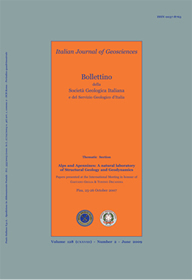
The instrumental seismicity of the Abruzzo Region in Central Italy (1981-2003): seismotectonic implications
Paolo Boncio(*), Debora Paola Tinari(*), Giusy Lavecchia(*), Francesco Visini(*) & Giuliano Milana(**)
(*) Geodynamics and Seismogenesis Laboratory, Dipartimento di Scienze della Terra, Università «G. d'Annunzio», Chieti, Italy.
(**) INGV - Istituto Nazionale di Geofisica e Vulcanologia, Rome, Italy.
Corresponding author: P. Boncio, e-mail: pboncio@unich.it.
Volume: 128 (2009) f.2
Pages: 367-380
Abstract
We analyse the instrumental seismicity of the Abruzzo region in the period 1981-2003 in order to obtain a catalogue as homogeneous as possible in terms of location procedure and quality of the results. We analyse four temporal datasets: 1981-1991; 1992-1996; 1997-1999 and 2000-2003. The 1981-1991 dataset is taken from the CSTI catalogue, opportunely selected by using quality criteria. The datasets from 1992 to 2003 are relocated by integrating the recordings of the national seismic network with the recordings of the local Abruzzo seismic network (operating from 1992 to 1999). Particular attention is paid to the velocity models, in order to account for the different stratigraphic/tectonic domains which characterize the Abruzzo region. In particular, we used 8 velocity models, applied to stations or groups of stations lying within relatively homogeneous areas. We obtained a database, selected for RMS ≤0.5s and hypocentral errors ≤5 km, of 985 events with 0.5≤M≤4.4 plus two events of moderate magnitude (Mw=5.9, Mw=5.5) corresponding to the largest shocks of the May 1984 Sangro Valley seismic sequence. We also computed 17 new focal mechanisms. The seismotectonic implications mainly concern the thickness of the seismogenic layer. A robust statistical estimate of the base of the seismogenic layer is given by the depth above which the 90% of seismicity occurs (D90). The maximum thickness (15-17 km) is found in the eastern Abruzzo Apennines (surface heat flow ≤40 mW/m2). A thickness of 12-14 km is found in the western Abruzzo Apennines (40< surface heat flow ≤60 mW/m2). The observed depths are consistent with independent rheological data (B-D transition). The connection between the background seismicity and the geometry at depth of the active faults is feasible only rarely (e.g. M. Gorzano normal fault in northern Abruzzo). More often the seismicity is spread within the seismogenic volume. Locally, it concentrates close to structural complexities or defines small seismic sequences activating inherited structures. The active faults south of L'Aquila are almost free from microseismic activity. The new focal mechanisms computed from the 1992-1999 database confirm and reinforce the existence of a dominating extensional regime across the Abruzzo Apennines.
Keywords
Get Full Text